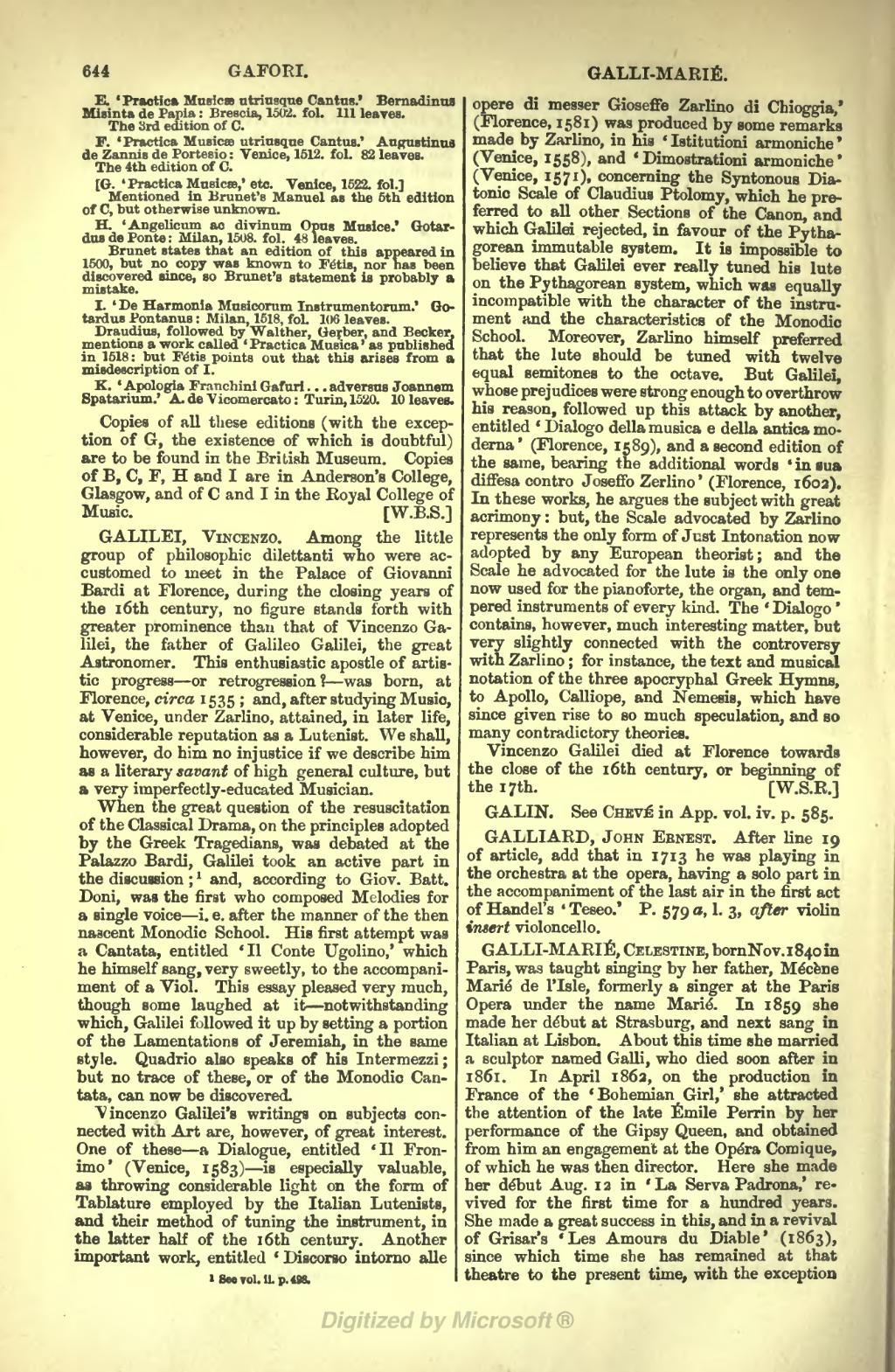E. 'Practica Musicæ utriusque Cantus.' Bernadinus Misinta de Papia: Brescia, 1502. fol. 111 leaves.
The 3rd edition of C.
F. 'Practica Musicæ utriusque Cantus.' Augustinus de Zannis de Portesio: Venice, 1512. fol. 82 leaves.
The 4th edition of C.
[G. 'Practica Musicæ,' etc. Venice, 1522. fol.]
Mentioned in Brunet's Manuel as the 5th edition of C, but otherwise unknown.
H. 'Angelicum ac divinum Opus Musice.' Gotardus de Ponte: Milan, 1508. fol. 48 leaves.
Brunet states that an edition of this appeared in 1500, but no copy was known to Fétis, nor has been discovered since, so Brunet's statement is probably a mistake.
I. 'De Harmonia Musicorum Instrumentorum.' Gotardus Pontanus: Milan, 1518, fol. 106 leaves.
Draudius, followed by Walther, Gerber, and Becker, mentions a work called 'Practica Musica' as published in 1518: but Fétis points out that this arises from a misdescription of I.
K. 'Apologia Franchini Gafuri ... adversus Joannem Spatarium.' A. de Vicomercato: Turin, 1520. 10 leaves.
Copies of all these editions (with the exception of G, the existence of which is doubtful) are to be found in the British Museum. Copies of B, C, F, H and I are in Anderson's College, Glasgow, and of C and I in the Royal College of Music.
GALILEI, Vincenzo. Among the little group of philosophic dilettanti who were accustomed to meet in the Palace of Giovanni Bardi at Florence, during the closing years of the 16th century, no figure stands forth with greater prominence than that of Vincenzo Galilei, the father of Galileo Galilei, the great Astronomer. This enthusiastic apostle of artistic progress—or retrogression?—was born, at Florence, circa 1535; and, after studying Music, at Venice, under Zarlino, attained, in later life, considerable reputation as a Lutenist. We shall, however, do him no injustice if we describe him as a literary savant of high general culture, but a very imperfectly-educated Musician.
When the great question of the resuscitation of the Classical Drama, on the principles adopted by the Greek Tragedians, was debated at the Palazzo Bardi, Galilei took an active part in the discussion;[1] and, according to Giov. Batt. Doni, was the first who composed Melodies for a single voice—i.e. after the manner of the then nascent Monodic School. His first attempt was a Cantata, entitled 'Il Conte Ugolino,' which he himself sang, very sweetly, to the accompaniment of a Viol. This essay pleased very much, though some laughed at it—notwithstanding which, Galilei followed it up by setting a portion of the Lamentations of Jeremiah, in the same style. Quadrio also speaks of his Intermezzi; but no trace of these, or of the Monodic Cantata, can now be discovered.
Vincenzo Galilei's writings on subjects connected with Art are, however, of great interest. One of these—a Dialogue, entitled 'Il Fronimo' (Venice, 1583)—is especially valuable, as throwing considerable light on the form of Tablature employed by the Italian Lutenists, and their method of tuning the instrument, in the latter half of the 16th century. Another important work, entitled 'Discorso intorno alle opere di messer Gioseffe Zarlino di Chioggia,' (Florence, 1581) was produced by some remarks made by Zarlino, in his 'Istitutioni armoniche' (Venice, 1558), and 'Dimostrationi armoniche' (Venice, 1571), concerning the Syntonous Diatonic Scale of Claudius Ptolomy, which he preferred to all other Sections of the Canon, and which Galilei rejected, in favour of the Pythagorean immutable system. It is impossible to believe that Galilei ever really tuned his lute on the Pythagorean system, which was equally incompatible with the character of the instrument and the characteristics of the Monodic School. Moreover, Zarlino himself preferred that the lute should be tuned with twelve equal semitones to the octave. But Galilei, whose prejudices were strong enough to overthrow his reason, followed up this attack by another, entitled 'Dialogo della musica e della antica moderna' (Florence, 1589), and a second edition of the same, bearing the additional words 'in sua diffesa contro Joseffo Zerlino' (Florence, 1602). In these works, he argues the subject with great acrimony: but, the Scale advocated by Zarlino represents the only form of Just Intonation now adopted by any European theorist; and the Scale he advocated for the lute is the only one now used for the pianoforte, the organ, and tempered instruments of every kind. The 'Dialogo' contains, however, much interesting matter, but very slightly connected with the controversy with Zarlino; for instance, the text and musical notation of the three apocryphal Greek Hymns, to Apollo, Calliope, and Nemesis, which have since given rise to so much speculation, and so many contradictory theories.
Vincenzo Galilei died at Florence towards the close of the 16th century, or beginning of the 17th.
GALIN. See Chevé in App. vol. iv. p.585.
GALLIARD, John Ernest. After line 19 of article, add that in 1713 he was playing in the orchestra at the opera, having a solo part in the accompaniment of the last air in the first act of Handel's 'Teseo.' P. 579a, l. 3, after violin insert violoncello.
GALLI-MARIÉ, Celestine, born Nov. 1840 in Paris, was taught singing by her father, Mécène Marié de l'Isle, formerly a singer at the Paris Opera under the name Marié. In 1859 she made her début at Strasburg, and next sang in Italian at Lisbon. About this time she married a sculptor named Galli, who died soon after in 1861. In April 1862, on the production in France of the 'Bohemian Girl,' she attracted the attention of the late Émile Perrin by her performance of the Gipsy Queen, and obtained from him an engagement at the Opéra Comique, of which he was then director. Here she made her début Aug. 12 in 'La Serva Padrona,' revived for the first time for a hundred years. She made a great success in this, and in a revival of Grisar's 'Les Amours du Diable' (1863), since which time she has remained at that theatre to the present time, with the exception
- ↑ See vol. ii. p.498.
